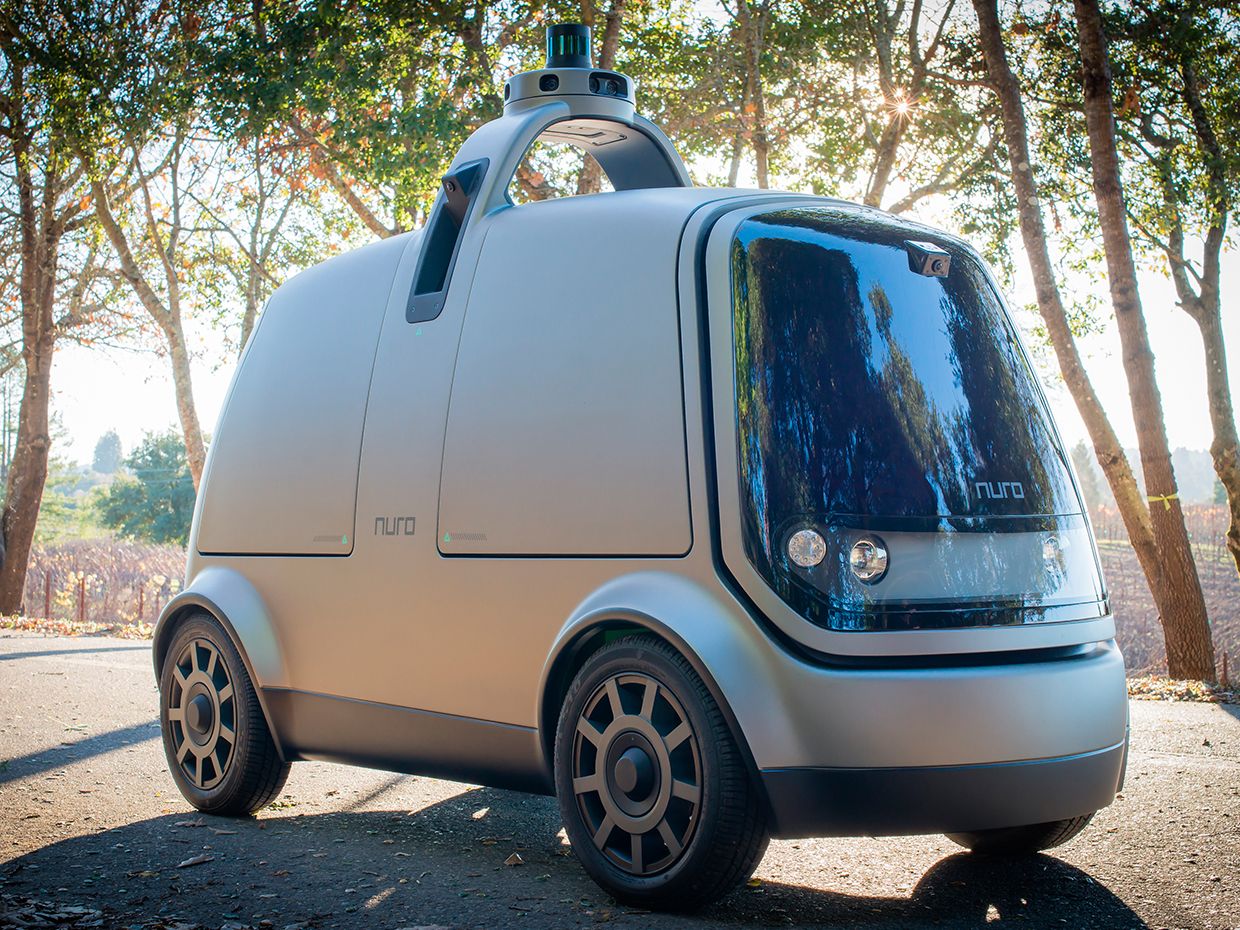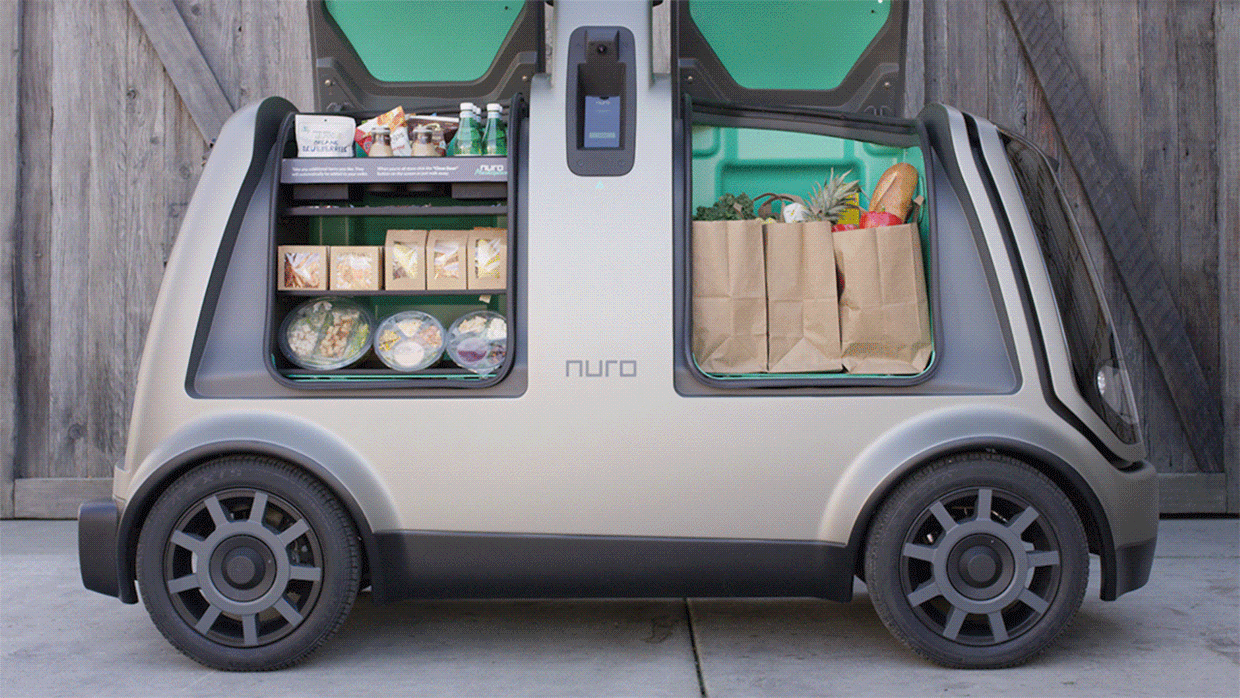Somewhere between a delivery truck and a sidewalk robot, Nuro’s robotic vehicles want to deliver your groceries

Photo: Nuro
It seems like we’ve gotten to the point with self-driving vehicles where it’s no longer enough to “just” be developing a car that could at some point be used as an autonomous rideshare vehicle. That space has gotten super crowded over the last few years and although it may not seem like it, the giant piles of money that self-driving vehicle (SDV) startups require are not infinite. So, what we’re seeing instead is more specialization into niches where specific sorts of SDVs can fulfill specific business cases.
The most popular (and realistic in the near term) niche is almost certainly delivery, because delivering stuff is what vehicles do when they’re not delivering people. This niche is being tackled at all scales, from Tesla’s autonomous semi trucks to sidewalk delivery robots from Starship and Piaggio Fast Forward. And now, somewhere in the middle, there’s Nuro.
Today, Nuro is announcing not only the fact that it exists, but also that it’s got one of those aforementioned giant piles of money ($92 million in Series A funding) along with a fully autonomous self-driving vehicle “designed to transform local commerce” by bringing things you want from local businesses directly to your home.
“We started Nuro to make products that will have a massive impact on the things we do every day,” said Nuro Co-founder Dave Ferguson. “Our world-class software, hardware, and product teams have spent the past 18 months applying their expertise to deliver on this mission. The result is a self-driving vehicle designed to run your errands for you. It is poised to change the way that businesses interact with their local customers.”
Nuro’s new vehicle is designed specifically to move goods between and among businesses, neighborhoods, and homes. The fully autonomous vehicle is unmanned and about half the width of a passenger car. It’s built with ultra-light materials and designed for neighborhoods. These combined design elements will make it one of the safest vehicles on the road.
Leading the team at Nuro are Dave Ferguson and Jiajun Zhu, who were two of the top engineers in Google’s self-driving vehicle group. They left Google in 2016 to found Nuro, and managed to convince folks from Waymo, Uber, Tesla, as well as Stanford and MIT and many other high-profile companies and research institutions, to come work with them on Nuro’s SDV.
The vehicle itself is, well, you know as much as we know just from watching the video—Nuro seems to be in announce-its-existence mode as opposed to discuss-technical-details mode. It looks like they’re relying on what could be a Velodyne Ultra Puck lidar, along with a comprehensive array of cameras all around the vehicle, for localization and obstacle avoidance. There could be more lidars hidden under there as well, but if it’s just the one Velodyne plus a bunch of cameras, that could help keep the cost of the SDV down. We’re actually not even sure what to call this thing; apparently it’s officially just known as “the vehicle,” although the internal nickname is “R1” and we’ll stick with that for now because it’s less awkward.

R1 is designed to transport goods (a good being anything that will fit into its capacious compartments) for delivery, return, or even for purchase. Nuro hasn’t explained exactly how it would work, but I would guess that you’d (say) order a week’s worth of groceries, and then pay a fee to have those groceries show up at your place in one of Nuro’s vehicles. Or maybe it’s lunchtime, and an R1 shows up with a bunch of different food options that you can purchase from it directly. Nuro calls this “last mile transportation,” although it seems like it might be more accurate to bump that up to perhaps 16 kilometers (10 miles) to differentiate R1 from sidewalk robots in terms of more than just payload, since R1 is intended to drive autonomously for longer distances on city streets.
For a bit more detail, we spoke with Nuro co-founder Dave Ferguson via email.
IEEE Spectrum: From an engineering and robotics perspective, what’s unique about Nuro’s SDV?
Dave Ferguson:
The application is unique. Our first product is the first mass market self-driving local commerce vehicle. Specifically built for the fully autonomous transportation of goods, the vehicle is custom-designed from the ground up to be safer, nimbler, and more efficient than anything on the road. It features lightweight materials, narrow width, custom hardware for redundancy, and a breakthrough design to keep what’s outside even safer than what’s inside.
A fully unmanned vehicle, the vehicle has been tested on private roads. The sensor stack involves cameras, LIDAR, RADAR—all to provide the vehicle with as much perception and awareness as possible. This is not an ultra low speed sidewalk robot; it will drive on neighborhood (urban and suburban) roads very soon.
The full vertical integration of software, hardware, and design in house at Nuro also makes this vehicle unique.
Spectrum: What problem is Nuro solving with its SDVs, and why are SDVs the best way to solve that problem?
Ferguson:
Nuro’s mission is to accelerate the benefits of robotics for everyday life. We think about a wide range of problems to solve. Our first application is the transportation of goods between and among businesses, neighborhoods, and homes.
The last mile transportation contributes to 30 to 50 percent of the total logistics cost of goods transportation; the problem is real and costly. We realized we could create an entirely new kind of vehicle designed purely for goods transportation and reduce this cost. Importantly, this sort of vehicle could also be created sooner, more efficiently, and safer than passenger transportation. Because of its flexible interior, R1 can be re-configured for its specific purpose in that delivery.
Spectrum: What did you learn from Google’s SDV program that you’ve applied to Nuro?
Ferguson:
Google inspired us to do something with worldwide impact. Google’s SDV project greatly accelerated a future where up to a million lives a year will be saved. We wanted to transform other industries in the same way Google changed the future of self-driving passenger cars. When Google launched the self-driving car project in 2009, people thought they were crazy. Now they’re the category leader. We took that same sense of mission and impact, and created Nuro.
Spectrum: How do you attract talent to Nuro, when there are so many other high-profile SDV companies out there?
Ferguson:
Nuro engineers have a unique opportunity to design both hardware and software from the ground up and solve technically challenging problems in a deeply vertically-integrated approach.
Nuro’s team is made up of the very best minds from academia and industry. We are veterans in robotics, consumer electronics, autonomous vehicles, and automotive—from Google, Waymo, Apple, Uber, Tesla, GM, FitBit, and many of the world’s top universities (CMU, Berkeley, Stanford, MIT, UNC, Harvard, Toronto, Princeton, and Chicago). And we have winners of various world competitions (including DARPA Urban Challenge, DARPA Robotics Challenge, and ImageNet).
Spectrum: What has been the biggest unexpected challenge you’ve had to solve while developing the vehicle?
Ferguson:
The vehicle is unique and unlike any other vehicle designed before; we had to build a team of the most talented people in the hardware, design, UX, and automotive industries to design it from the ground up.
Because it never carries passengers (which means we can’t put safety operators in the robot), testing the vehicle’s software on roads required a very different set of practices than testing traditional passenger self-driving cars. Our team developed many novel in-house approaches to make sure our testing is always safe.
Whether you think of Nuro’s R1 as an oversized sidewalk robot or an undersized autonomous delivery van, it’s certainly something a bit different that seems like it could be useful in the near term and (as Dave mentions) somewhat easier and safer to deploy than a full-size, full-weight vehicle. And removing the human completely is an excellent idea; hopefully the trust that Nuro has in its autonomy hardware and software will justify that decision.
So far, R1 has been operating with full autonomy on private roads. Our guess is that for the foreseeable future, it’ll be chased (as it is in the video) by some humans in a car with their hands hovering over an e-stop, and it’s not entirely clear to me whether that’ll qualify as a safety driver on public roads at the moment. It’s also important to remember that the public road experience for R1 will be much different because the world is full of crazy people. We’re not sure what Nuro’s timeline is, so while it’s great that they’ve got this prototype up and running, it may take them a little while before the vehicle is doing anything practical, and our guess would be that it’ll first start driving around in a highly controlled environment, like on a college campus or within a specific community.
The other fun thing to think about is what problems Nuro doesn’t seem to solve—for example, in order for it to work in its current incarnation, you need to be at home and have pants on so that you can go outside and meet R1 on the street when it pulls up. This is where a robot like Cassie could step in, to take care of that extraordinarily tricky last 10 meters between the street and your front door. This is just speculation, of course, but it would be totally cool to see in practice.
Dave did also mention that the last 16 kilometer delivery thing is only Nuro’s “first application”—we’re not sure what else they have planned, but it’s a unique and versatile platform that has a lot of potential, and we’re excited to see what they make of it.
